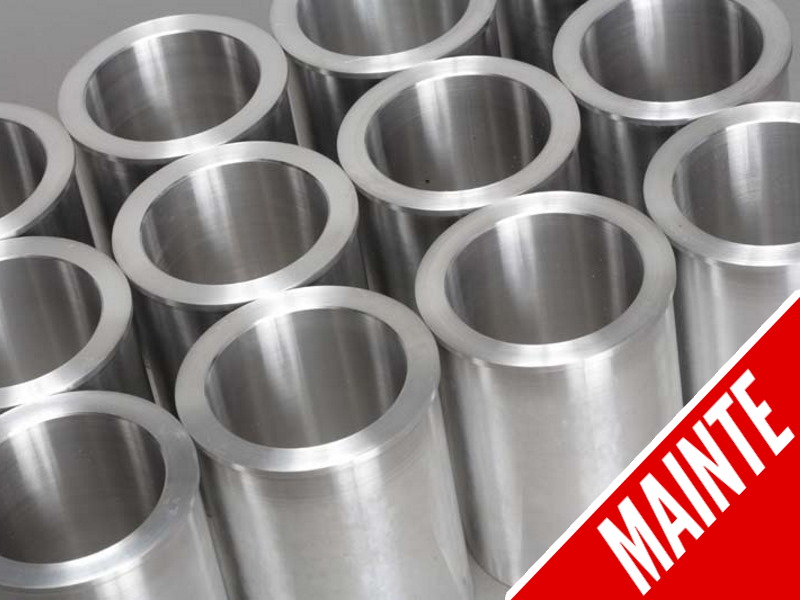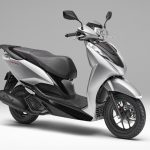Since long ago, cast iron has been the preferred material for cylinder sleeves. The transition from cast iron sleeves to aluminum + special plating sleeves began in the 1970s. In the motorcycle world, Italian motorcycles were the first to adopt aluminum-plated sleeves for cylinders. Here, we would like to reconfirm the features and wonderful potential of the much-talked-about "aluminum-plated cylinder sleeve = ICBM cylinder."
Focus on aluminum material, which is lighter than steel and dissipates heat better


In contrast to the manufacturer's genuine cast iron sleeve (left) pulled from the cylinder, the ICBM sleeve is machined from a special aluminum muku material and finished with plating. The sleeve itself is 1/3 the weight of a cast iron sleeve of the same size. This is understandable considering the specific gravity of iron and aluminum. Another feature of ICBM cylinders is that they cannot be broken in as cylinders due to their high surface hardness and excessive hardness. Plateau honing technology, which creates a state where break-in is completed by mechanical technology, is indispensable for the plated bore.
ICBM with special plating in sleeve condition


The conventional setup was to press-fit the machined aluminum sleeve into the cylinder and then plating the entire cylinder. The new system enables the production of Currently, the Φ66.The "Ever Sleeve (patented)" kit of ICBM sleeves with pre-plated and plateau honed finish, compatible only with the 5mm Kawasaki Z1 stock oversized pistons, is now also available.
Kawasaki Z1s with the same size bore can now be manufactured by internal combustion engine stores throughout Japan.
It is also applicable to a variety of models


Cylinder that has undergone ICBM conversion to match the bore-up pistons for the Suzuki Hayabusa. Even if the stock cylinder originally has an aluminum sleeve, if you want to install an oversized piston, ICBM makes it possible to use an aluminum sleeve specification.
An actual example of ICBM cylinder made by combining a stock cylinder and Wiseco piston for Yamaha SR. A hole is machined in the center of the aluminum material on the right, and then the material is machined into a thin sleeve shape.
The "Intake/exhaust port with columns" makes it possible to achieve this.


Not only large Kawasaki triples, but also middle class 2-stroke triple 350SS/ICBM cylinder for S2. The port holes are machined into the machined aluminum sleeve, then plated, and the procedure is finished by press-fitting the new sleeve into the cylinder barrel with the cast iron sleeve machined off.
By "pillaring" the center of the port and making it a pillared intake and exhaust port, wear resistance is greatly improved without piston pivoting or piston rings expanding into the port holes.
This technology is commonplace in works machines, but in mass-production vehicles, ports with pillars have often been avoided due to manufacturing problems.
Plateau honing + machining accuracy control data


Measuring the inside diameter of an SR-ICBM cylinder with a surface roughness meter after plateau honing. Plateau honing is not complete without this measurement technique.
Plateau honing technology is to plane the surface over jagged peaks. The plateau is a plateau, while the jagged valley is a cross-hatch groove, which plays an important role in retaining lubricating oil. A graph of the surface roughness meter measurement results is printed out and given to the user at the time of delivery.
The upper side of the graph line is the sliding side of the piston. This side has no protrusions and has a plateau = high original shape.
On the opposite side, a deep "cross hatch" is formed. The oil retention groove makes the sliding surface 1.5 times larger than normal./10 smoothness.
Interviewed by iB Inoue Boringhttps://www.ibg.co.jp/
- Point 1 ・ Special plating treatment boasts overwhelming cylinder bore hardness, heat dissipation resistance, and heat conduction resistance.
- Point 2 - The cylinder is made of the same aluminum material as the piston, so the expansion coefficient is small and the piston clearance can be reduced.
- Point 3 - Newly manufactured replacement sleeves that can recover the shortcomings of 2-stroke engines in particular.
iB Inoue Boring in Saitama Prefecture is celebrating its 70th anniversary as a professional store for machining internal combustion engines. iB Inoue Boring was in charge of manufacturing big bore cylinders for Harley-Davidson made by world famous manufacturers in the 1970s.
On the domestic scene, the company is a group of highly competent internal combustion machine machining professionals who were contracted to manufacture genuine repair cylinders for motorcycle manufacturers, i.e., parts supplied by genuine parts suppliers. It was in the late 1980s that the company began to develop its "plated bore finishing" technology.
The company began machining aluminum cylinders with special plating at the request of a motorcycle manufacturer. Previously, cast iron sleeve specifications were common, but from the late 1980s onward, many sports models were converted to "plated cylinders. It was Inoue Boring that had been involved in the manufacture of plated cylinders since that time.
The "Manufacturing Department" at that time handled work commissioned by motorcycle manufacturers, and the "Service Department" applied that technology for general users. It was also Inoue Boring who thought that by providing the technology for general users, "you should be able to feel the benefits of it.
The difference in "surface hardness," as measured by Vickers hardness, was two orders of magnitude greater, resulting in overwhelming durability, light weight, good heat dissipation, and the ability to maintain constant piston clearance because the expansion rate was extremely close to that of aluminum pistons.
Moreover, the cylinder's ideal performance is achieved by the fact that it does not seize easily and slides well, which means low sliding resistance! They wanted to make it available to a larger number of general users.
The biggest problem was the "plating process setup. In order to apply electrolytic plating, which is equivalent to that of mass-produced cylinders, it was necessary to invest high costs for each model to manufacture special jigs for plating, electrodes, and diamond grinding wheels for honing. In other words, huge costs were required for each new model. Inoue Boring overcame this problem with an idea.
This method eliminated the need to make jigs and electrodes for each model. Instead of plating the finished cylinder, the sleeve (cylinder) is plated first, and the plated sleeve is press-fitted into the cylinder barrel.
The plated sleeve is then press-fitted into the cylinder barrel, and the inner diameter is then finished by honing.!?He thought, "I'm going to do it. Using this method, they were able to secure the cooperation of a plating company so that they could plate sleeves of various sizes. It took about 10 years since they started researching diversification. Now, they are able to produce both 2-stroke and 4-stroke engines.
We have a system in place that can accommodate "Φ52 to 100mm" in the finished dimensions of the inner diameter (Φ100mm is also available in response to needs from 4-wheel Porsche and Mercedes users), and we have already put this technology into practice on numerous models. This technology has already been put into practice on a number of models and has been well received by many users.
In the past, users would have requested cast iron sleeves for repairs, but when ICBM was proposed, they were convinced and orders are increasingly being accepted. In addition, recently, there have been an increasing number of cases where users have suddenly received repair parts with an order sheet requesting that the parts be finished with ICBM.
In particular, the Kawasaki 500SS, which the company has been working on since early on/H1 and 750SS/The popularity of ICBMs for H2 is so great that requests for ICBMs with aluminum-plated cylinders and "ICBMs with pillars," which have guide pillars on the intake and exhaust ports, are increasing, rather than the usual oversize modifications.
Models of the air-cooled 2-stroke era, which pursued high power, were characterized by large intake and exhaust ports. The large ports were known to affect the edge of the exhaust port with the piston ring edge easily caught by the piston ring tension, and the wear rate of each sliding part was known to be faster because of this. Since the new aluminum sleeve is made by NC machine tools, a sleeve that enables smoother reciprocating motion of the piston is produced by "manufacturing the sleeve with data with guide columns that prevent the piston from swiveling" at the intake and exhaust ports.
The high reputation of ICBM cylinders among users who have installed them has spread by word-of-mouth, and more and more cases of ICBMs with columns are being considered, especially for large-displacement, big-bore, 2-stroke engines. One such example is the Yamaha DT1, a pioneer in off-road motorcycles, and it seems that the excellence of ICBMs with columns is gradually spreading.
The Kawasaki Z1 is the most popular model of the ICBM cylinders, and now we are supplying sleeves with standard oversize bore, special plating and plateau honing only for the Kawasaki Z1 cylinder, which is in high demand, so that other internal combustion machine processing pro stores can also convert to ICBM cylinders.
The company also offers "Eversleeve (patented)" sales. This has attracted a great deal of attention. ICBM is also a solid technology for the concept of "modernization," which Inoue Boring continues to insist on. Modernization" does not mean a special tune-up, but rather, by adopting modern processing technology and modern materials and surface treatment technology, even an old car engine that had weaknesses at the time of manufacture can be converted to an engine specification that runs smoothly and comfortably, even if it is still in stock specs.
With such a concept, ICBM technology is truly one of the great success stories of using modern technology to overcome the engine's weaknesses.



